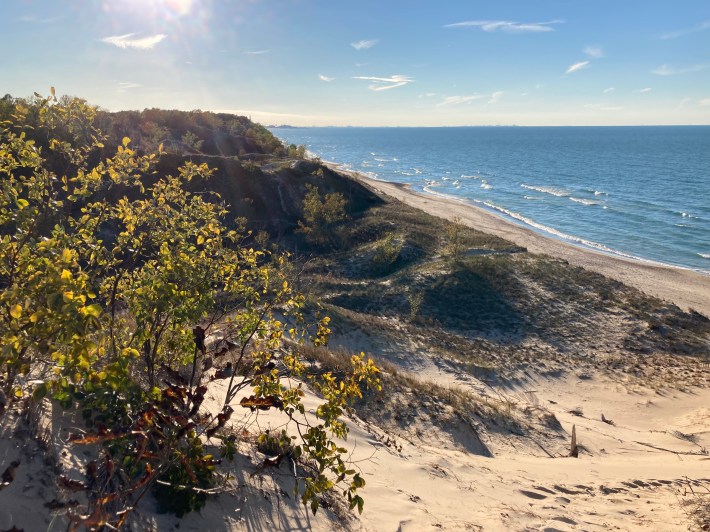Last Friday I took advantage of one of Chicagoland's multiple opportunities for easy car-free camping by taking my bike on the South Shore Line and heading to the Indiana Dunes National Park, one of my favorite autumn destinations. (It's also very convenient to do this as a backpacking trip, since the Beverly Shores station is a short walk from lovely Dunewood Campground, but I brought my bike so as to have more flexibility for accessing different hiking trails and beaches.)

As I was about to buy a ticket from a machine on the platform at downtown Millennium Station, I was pleasantly surprised when a fellow passenger told me that I didn't need to pay, because all eastbound trips are currently free all day on all weekdays. I was a little skeptical, but the commuter railroad's website confirmed that the promotion started last month and was continuing through Halloween – I'm not quite sure how I missed the memo on this. The webpage said the purpose of the the policy is "to show appreciation for passengers continuing to utilize the South Shore Line throughout the COVID-19 pandemic, and welcome those who are new or just returning."
I wrote Mike Noland, president of the Northern Indiana Commuter Transportation District, which runs the South Shore Line, to ask whether the railroad has any numbers that suggest that the free weekday eastbound rides program is encouraging more ridership overall, and is possibly a net win for revenue. Noland called back to say that he had just gotten out of a meeting where it was decided the policy would be extended until the end of the year.

"We don't have any specific metrics on how the promotion is working out," Noland said. "A lot of this is art rather than science. But we are in the process of trying to get people comfortable riding trains again [as society recovers from the COVID-19 pandemic.] But to the extent that we can incentivize the public to ride trains, it's a worthwhile investment."
According to Noland, the South Shore Line saw steady ridership increases this summer after vaccines were rolled out, and management was expecting that Labor Day would be a benchmark for more growth. "But the Delta Variant hit hard, and ridership plateaued. I've been monitoring peer systems around the country, and they seemed to have the same experience."
By that point the South Shore Line had hit 25 to 30 percent of average 2019 weekday ridership levels, and about 40 percent of pre-pandemic weekend ridership, so it appears discretionary ridership recovered faster than work commutes, Noland said.
Right now the railroad is at roughly 40 percent of pre-pandemic ridership levels on weekdays, and 60 to 70 percent on weekends, according to Noland. "So, knock on wood, part of it seems to be COVID numbers are improving and employers are bringing people back to work."
In September and October, when the promotion has been in place, the South Shore Line has seen an increase in weekday rides, Noland said. The railroad isn't offering the free eastbound rides on weekends because, again, discretionary trips seem to have rebounded faster.
You may recall that in late 2020, the railroad offered free westbound rides, and in contrast to the current promotion that was only on weekends. Noland said the South Shore Line discontinued that program because there were some issues ("not a huge amount") with riders refusing to pay for the eastbound leg of their trip on their way home. But for some reason that's been less of a problem with the free eastbound weekday trips.
Another promotion that the South Shore Line has been doing since the start of the pandemic is buy-one-get-one-free monthly passes. "Monthly passes [which are largely used by downtown Chicago employees] took the biggest hit during COVID, so we wanted to encourage downtown commuters who were riding to keep riding."

After I enjoyed hiking in the Dunes in lovely weather on Saturday, on Sunday morning a hard rain fell, so I caught train 506, leaving the Dune Park station at 1:15 p.m., back to the city. When we arrived at Millennium, the platform was so full of people, it took a few minutes for the crowd to amble to the station house. (Mask compliance seemed to be good.) When I told Noland about this, he checked the ridership records and confirmed the eight-car run had been nearly full, with 705 passengers out of a possible 766. He wasn't sure what had spurred the ridership, but the free eastbound trips on Friday couldn't have hurt matters.
"I've been telling people that, in the short term, the generation of revenue is really secondary to getting people to ride the trains," Noland concluded. "If you're just chasing revenue, you're missing what the issues are right now. In order to get back to the revenue that we need to generate in the long term, we need to incentivize people to get back on the trains."





